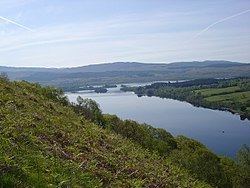Catchment area 840 km (320 sq mi) Length 41 km Surface elevation 36 m Cities Lochawe | Basin countries Scotland Area 38.5 km² Width 1 km | |
 | ||
Primary inflows Islands | ||
Loch Awe (Scottish Gaelic: Loch Obha) is a large body of freshwater in Argyll and Bute, Scottish Highlands. It has also given its name to a village on its banks, variously known as Loch Awe, or Lochawe. There are islands within the loch such as Innis Chonnell and Inishail.
Contents
- Map of Loch Awe United Kingdom
- Dinghy cruising on loch awe sailing in a heron dinghy with mirror dinghy sails and wild camping
- The loch
- Hydroelectric schemes
- Tourism
- The 3 Lakes Challenge
- History
- Environs
- References
Map of Loch Awe, United Kingdom
Dinghy cruising on loch awe sailing in a heron dinghy with mirror dinghy sails and wild camping
The loch
It is the third largest freshwater loch in Scotland with a surface area of 38.5 square kilometres (14.9 sq mi). It is the longest freshwater loch in Scotland, measuring 41 kilometres (25 mi) from end to end with an average width of 1-kilometre (0.62 mi). The loch runs approximately south-west to north-east, roughly parallel to the two sea lochs of Loch Etive and Loch Fyne. Via the River Awe and Loch Etive it drains westward from its northern end and thus into the Atlantic Ocean. At the narrowest section of the loch are North Port (Taychreggan Hotel) and South Port (Portsonachan Hotel). Once used by cattle drovers, a ferry ran between these shores to facilitate crossing to markets beyond. The Transatlantic Cable, which runs through the village of Kilchrenan, was laid across at this point in 1955.
Hydroelectric schemes
Loch Awe is the site of two hydroelectric projects. One is a conventional turbine power station, created by damming the River Awe in the Pass of Brander, feeding the water through underground pipes, and generating electricity as it flows into Loch Etive.
The second is a more unusual pumped storage project, using a man-made loch in the hills above the loch; water is pumped up during times of surplus power, and used to power generators at times of peak demand. The second project, known as Cruachan Dam from the name of the hill above, has a visitor centre, which includes tours into the heart of the mountain.
Tourism
Loch Awe is renowned for its trout fishing. Salmon pass through the loch, coming past the barrage in the River Awe and continuing into the River Orchy. Loch Awe contains several ruined castles on islands, and at the northern end has one of the most photographed castles in Scotland, Kilchurn Castle, which in summer may be visited by a short boat trip or by a half mile walk from a small car park just after the bridge over the River Orchy. Saint Conan's Kirk and Chapel of St Fyndoca are located in Loch Awe.
The 3 Lakes Challenge
The 40-mile Three Lakes Challenge (or Loch, Lake, Llyn) is a challenge which was first completed by a 5-person relay with Sam Plum, Jason Betley, Helen Gibbs, Helen Liddle, and Debbie Taylor on 3–4 July 2015 performed under 'English Channel Rules'. The course involves swimming the length of Loch Awe in Scotland (25 miles), then driving to the Lake District and swimming the length of Windermere (10.5 miles), and finally driving to Wales and swimming the length of Llyn Tegid - also known as Bala Lake (4 miles). This new challenge dubbed 'The 3 Lakes Challenge' set to be the swimming equivalent of the famous National Three Peaks Challenge. Furthermore, the relay swim along the length of Loch Awe on 3 July 2015 as part of the 3 Lakes Challenge is believed to be the first official relay crossing of Lake Awe under English Channel Rules.
History
One of the oldest Argyll clans, the Macarthurs owned lands around Loch Awe which was populated in close proximity with MacGregors, Campbells and Stewarts.
Clan Macarthur artefacts, including the four-poster state bed, are held at Inveraray Castle.
It was from Loch Awe and surrounding area that Clan Campbell established itself as a powerful family. In 1308, Robert the Bruce defeated the Clan MacDougall at the Battle of the Pass of Brander downstream from the loch.
Environs
The A85 road and the West Highland Line run along the northern bank of the loch, and the A819 follows the south-east bank for a short distance up to the village of Cladich. From there the single-track B840 runs for the remaining distance to the head of the loch at Ford and then joining the A816 a short distance north of Kilmartin. Similarly, on the north-west side an unclassified single-track road runs the full length from the A85 in Taynuilt to Ford.
At the northern tip of the Loch, a railway station was opened in 1880 when the Callander and Oban Railway passed that way, and a large luxury hotel was created (Loch Awe Hotel, 1871). There is also the Tight Line Bar which used to be the coach-house for the hotel. A village has grown up around the hotel, essentially running along the single strip defined by the A85 road. A steamer service used to operate on the loch from the pier just below the hotel, stopping at Portsonachan, Taycreggan, Eredine and Ford. The village now includes St Conan’s Kirk, one of the most interesting pieces of Church architecture in Scotland. Confusingly, while the railway station is called Loch Awe, the village is contracted to Lochawe.
